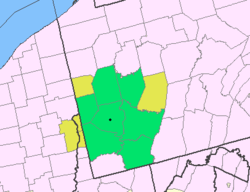 The Westmoreland Museum of American Art exterior | |
 | |
| Established | 1959 |
|---|---|
| Location | Greensburg, Pennsylvania, U.S. |
| Coordinates | 40°18′22″N79°32′41″W / 40.3060°N 79.5448°W |
| Type | Art museum |
| Accreditation | AAM |
| Collections | American art & sculpture |
| Founder | Mary Marchand Woods |
| Director | Silvia Filippini-Fantoni [1] |
| Architect | Ennead Architects |
| Employees | 26 [1] |
| Public transit access | N Main St + Park St (Museum) WCTA |
| Nearest parking | On site (no charge) |
| Website | thewestmoreland |
The Westmoreland Museum of American Art is an art museum in Greensburg, Pennsylvania devoted to American art, with a particular concentration on the art of southwestern Pennsylvania. [2]
Contents
Art lover and Greensburg resident Mary Marchand Woods hand down her entire estate to establish The Woods Marchand Foundation in 1949. The museum developed from this foundation, opening ten years later. [3]
The museum has expanded several times, beginning with a west-wing addition in 1968. [4] In 2015, the museum reopened after two years of major renovations to expand and modernize its facilities. The expansion added 13,287 square feet to its original 30,000 area, where a cantilevered wing was added for exhibitions. [3] [4]
William H. Gerdts wrote that
... in western Pennsylvania the Westmoreland Museum of Art in Greensburg, rather than the Carnegie Institute in Pittsburgh, has pioneered regional investigations. [5]
One feature of the museum is a Tim Prentice kinetic sculpture installed on the south facade. [6]





